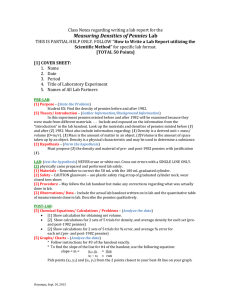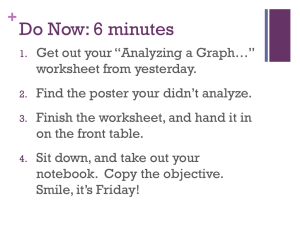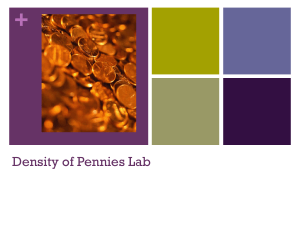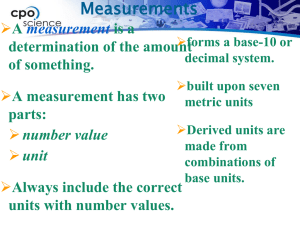Density of Pennies Lab
advertisement
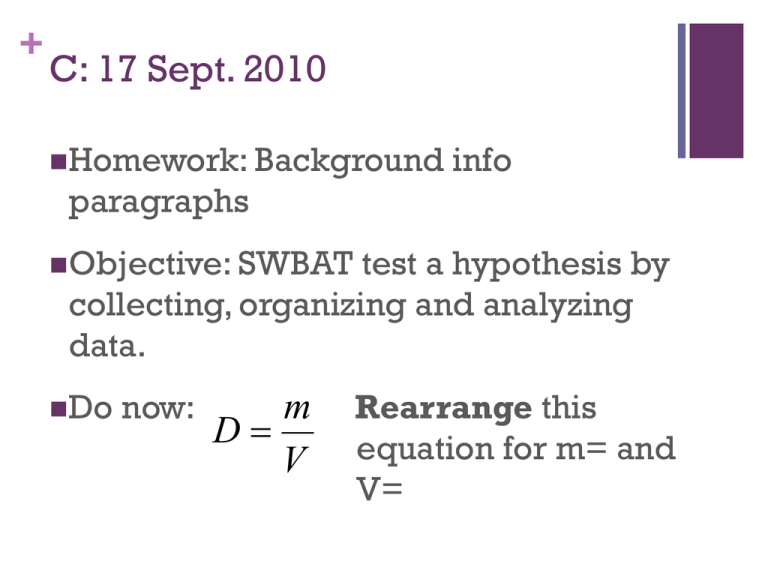
+ C: 17 Sept. 2010 Homework: Background info paragraphs Objective: SWBAT test a hypothesis by collecting, organizing and analyzing data. Do now: m D V Rearrange this equation for m= and V= + Agenda I. Do now II. Lab introduction III. Perform the lab! IV. Data analysis, graphing and drawing conclusions V. Intensive vs. extensive properties Homework: Week 2/3 Homework p. 1-2 + Density of Pennies Lab + Density A physical property of matter mass(g) density 3 volume(mL /cm ) The mass per volume of a substance. Units: g/mL 1 or g/cm3 mL = 1 cm3 + Calculate Density (or mass or volume) 1. An object with mass of 10.0 g, and volume of 20.0 mL 2. An object with mass of10.0 g and volume of 5 cm3 3. Calculate the mass of a sample of matter with a volume of 10.0 cm3 and density of 2.0 g/cm3 4. Calculate the volume of a rock with mass 100.0 g and density 5.00 g/mL. + The phenomenon In 1982, the density of pennies changed. + Your challenge: Determine, empirically, the density of pennies before and after 1982. 1. In your notebook (or piece of paper) write two hypotheses. 2. Carefully follow the procedure and collect data in an organized table. 3. Graph your data sets. 4. Write an analysis paragraph describing your graphed data sets. + Some details How can you determine the volume of a penny? Displacement Calculate the density of 2, 3, …10 pre1982 pennies, and 2, 3, …10 post-1982 pennies. Make a neat table and graph. + + An example of a good table. Table 1: Mass, volume and density of pre-1982 pennies Number of pennies 2 3 4 5 6 7 8 9 10 Mass (g) ±0.05g Volume (mL) ±0.5 mL Density (g/mL) + Data to record: 2 Hypotheses Data table for pre- and post-1982 pennies Average Graphs: density for each group mass vs. volume (2 sets of data on the same axes, do not connect dots!) + Intensive vs. extensive properties Intensive property: a physical property that does NOT depend on how much of a substance you have. Ex: temperature, velocity, melting point Extensive property: a property that DOES depend on how much you have. Ex: mass, length, volume + Intensive or extensive? I weigh 130 pounds. The car is moving 50 miles per hour. The length of a marathon is 24.6 miles. The Ice I density of water is 1.0 g/mL melts at 0oC. drank one liter of soda. (burp!) + So, is density intensive or extensive? How do you know? Discuss your graph, and what a graph of the other type might look like. + Homework: Week 2/3 p. 1-2: Thurs. Week 2/3 Homework, #6 ADD PICTURES + C: 17 Sept. 2010 Take out Homework: Graph of data Objective: SWBAT graph data using Excel. Do now: Describe two errors from your experiment yesterday. How could you make improvements to minimize this error? + Agenda I. Do now II. Homework check III. Graphing in excel Homework: Write an analysis paragraph + Making a graph Follow along in Excel as Ms. Boiteau shows you how to enter your data, and then how to make a graph. + A: 17 Sept. 2010 Get out Homework: None! Objective: SWBAT graph data and communicate an analysis in a complete paragraph. Do now: Log into your computer, open your email, and download your Excel file from yesterday. + Agenda I. Log in and download II. Finish graphing: adding in the “details” III. Print IV. Analyze graphs and write an analysis paragraph V. Notebooks! Homework: Finish analysis paragraph, write a conclusion + Writing an analysis of your data Write a paragraph describing your two data sets, but not explaining what the data mean. What data is shown on your graph? What is the shape of the data? Slope? Are there any outliers? What are they? Writing a conclusion + Restate hypothesis. Were your hypotheses supported by your data? Why or why not? Answer conclusion questions in a paragraph: Is density an intensive or extensive property? How do you know? Give evidence from your data. What elements are pennies made of? One of these elements has a density of 8.92 g/mL. How do your densities (before 1982 and after 1982) compare with the density of the pure element? Why do you think this is? How do you explain any difference in the density of the two groups? Use the results of this lab to make a hypothesis about how the composition (make-up) of the two groups of pennies is different. What do you think changed in 1982 (aside from density)? Why? (Connect conclusion to background info!!) + Homework Finish your analysis paragraph Write a conclusion Due Monday. Transfer notes into your new notebook (optional) (or bring $10 Monday for your notebook) + Write a Lab Report Title (incl. name, date, partner’s names) Background Objective Due (You info (from notes, etc.) (no hypothesis) Friday can start the procedure if you want!) + Title Your lab report should be titled with a title of your choosing. It should be relevant to the lab and should not just be the same as the title of a handout your teacher gave you. Do not have it on a separate title page. + Background Information Explain any important concepts that are central to understanding the experiment. In paragraph form, define any scientific terms necessary for understanding the lab. Link these concepts and terms together into a coherent paragraph + Objective and Hypothesis Explain what the purpose of the experiment or what goals you have in completing the lab. What do you hope to accomplish? Predict the results of the experiment. Explain your reasoning behind your hypothesis. State your independent, dependent and controlled variables. + Procedure For a lab where you have designed the procedure, include a detailed and complete account of every single step you completed during the lab, including how to make calculations. Be sure to include proper names for pieces of equipment! If you have followed a procedure given by your teacher, write a summary of what you did. Do not rewrite the given procedure word for word. + Data and Results Include any charts, graphs, tables, technical drawings, observations, or diagrams in this section. Include a one sentence caption for each. Data should be presented neatly, and with the use of computer software when possible. If any calculations were necessary during this lab, include them here. DO NOT explain the data. Mass vs. Volume of Pre- and Post-1982 Pennies Pre-1982 Pennies Post-1982 Pennies 4 Volume (mL) 3.5 3 2.5 2 1.5 1 0.5 0 0 5 10 15 20 25 30 35 Mass (g) Figure 1: Mass in grams vs. volume in mL of two groups of pennies (pre-1982 and post-1982) with a best-fit line. + Analysis Describe any patterns or trends in the data. Point out any relevant characteristics and comparisons that you see. Do not attempt to explain them, simply note them. Note the existence of any data that does not seem to fit the overall patterns/trends (ouliers). + Conclusions Draw conclusions from the patterns and observations you noted in the analysis section. Explain why the patterns you saw occurred. Was the experiment successful at completing the objectives above? Explain why or why not. Reflect on your hypothesis. Was it correct? Why or why not? Was there any significant error in your experiment? Propose some possible sources of error and explain how they might be improved. Answer questions (4) in lab handout in paragraph form. + Lab Report Due Next Monday This is your ONLY draft Typed!! This will be used as a ‘pre-test’ for your ability to write a lab report Will be compared to your lab reports as the year goes on to measure your progress! This does count as a lab grade! + Hand back background info paragraphs!

